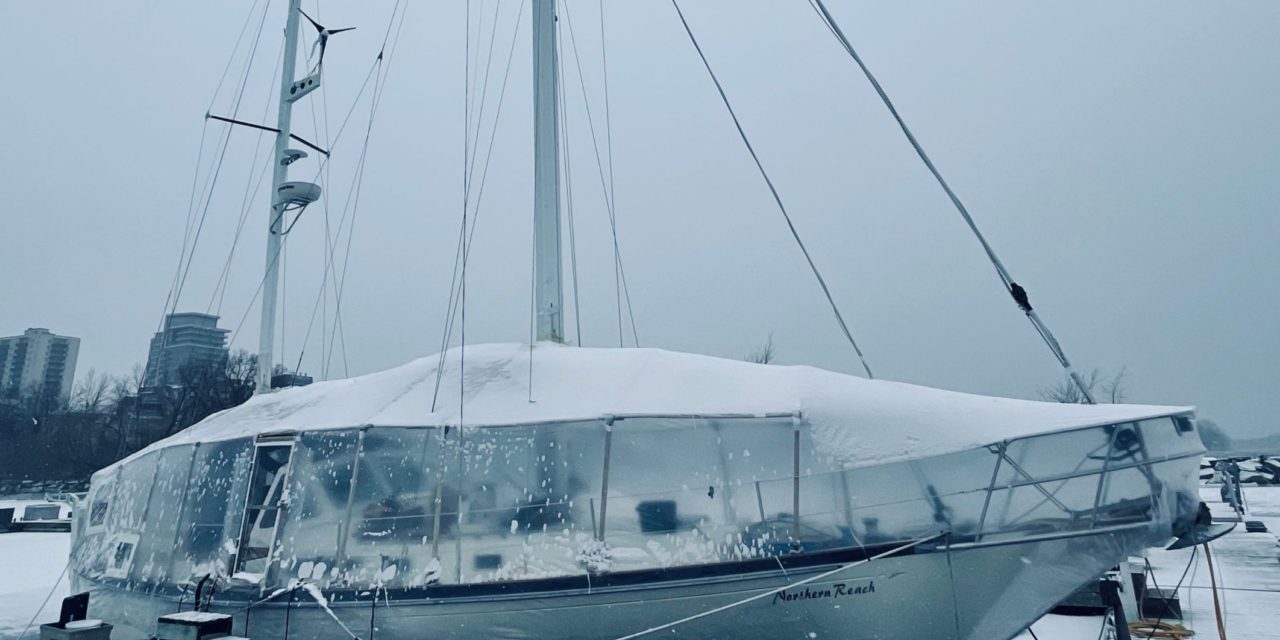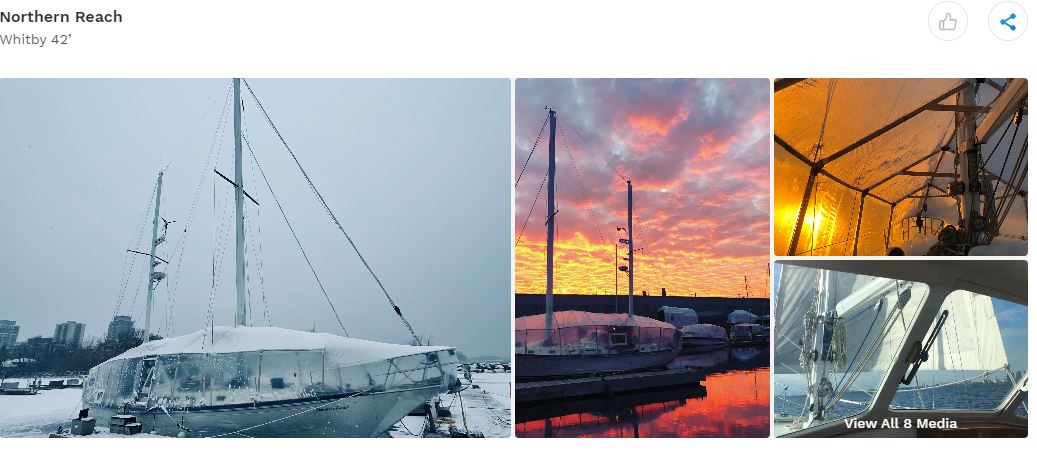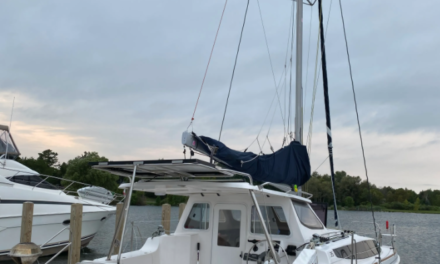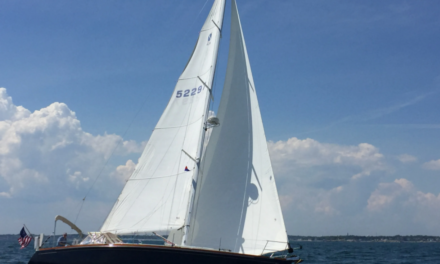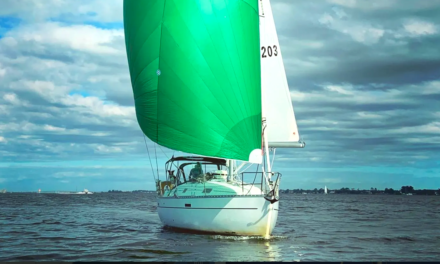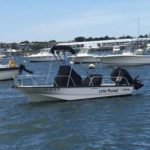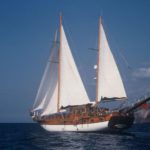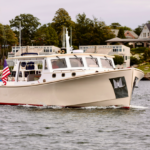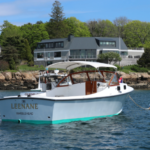“We do have the boat totally automated for winter temperature management… this means we can monitor the boat remotely, heaters and ice eaters (bubblers to keep the water from freezing around the boat) activate automatically, and humidity sensors make sure our bilges stay dry.”
Northern Reach, Whitby 42′
Interview with the Captains — Talia and Michel
On Long Range Cruising
Can you tell us a little about yourself and how you came to live onboard your boat?
We both grew up sailing but in very different ways: Michel used to race dinghy’s in his hometown lake up north as a child, but hadn’t been on a boat in years. Talia on the other hand grew up in Barbados and spent a few weeks each year cruising her Dad’s Beneteau in Thailand. As our relationship grew we realized that being near the water was most important, and so we bought our very first boat in 2018- a 1986 Mirage 35. We used it as a cottage to get away from the city on hot summer days. Not even 6 months ago, an acquisition Michel was working on fell through due to COVID, and so we thought, we were planning a big move, why not move onto a boat full time?! We never expected to find a blue water capable live aboard so quickly on Lake Ontario.
We took possession in October, and by November had her covered in shrink-wrap to weather the great Canadian winter- so sadly we’ve been tied to the dock, iced in, for far too long! It’s been really interesting getting to know the boat inside, but we’ve still so much to learn about how she sails! We did manage to do a 20nm trip with all 4 sails up mind you. Our 5 year plan, as our careers allow, is to sail her up the St. Lawrence River, to explore Canada’s east coast and then slowly make our way down to Barbados (where Talia grew up).
Most under-rated piece of equipment for long-range cruising?
Do you have any other notable resources you use (apps, devices, etc)
Mostly just the normal forecasting and navigation apps. We do have the boat totally automated for winter temperature management, however. This means we can monitor the boat remotely, heaters and ice eaters (bubblers to keep the water from freezing around the boat) activate automatically, and humidity sensors make sure our bilges stay dry. It gives us a bit more freedom during the winter, when we’re typically worried about being enclosed by ice, or losing power and having lines or seacocks burst inside the boat.
About your boat
We considered everything available between 40-54’ in our price range! The interesting part about our search was that initially we were leaning towards a few Bruce Roberts steel hulls – we loved the idea of being able to freeze in during the winter and not worry (ie: fly down to the Caribbean), but didn’t find anything in good enough condition. The steel hulled boats in our price range seemed plagued with rust issues.
We also looked at an Endeavour 43, Morgan Out Island 41, a few different Formosa models, and a few other 1980s era production boats. Ultimately, given the pandemic/travel situation, it wasn’t possible to go look at boats out of the country, and blue water capable boats are relatively uncommon on the great lakes. Fortunately, we found SV Northern Reach quite early in our search through a friend.
We had been looking quite seriously for a large liveaboard for about a month when, in our research into living aboard, one of the people we were introduced to noted that his neighbour was thinking about selling after 20 years of living aboard year-round. The boat was located a 20 minute drive from us, and had weathered the winters in fresh water, so we knew immediately that she was at least properly equipped for the task.
An introduction was made, and we found out that the owners were waiting for the right buyers – they wanted to sell to someone like us! A young couple with sailing experience that could take the boat on her next adventure. Not only was the boat in exceptional condition cosmetically, but she was very well documented. Every service in a log, every receipt filed, every equipment manual annotated.
The boat was purchased by its first owner who took sailed the boat often for about 10 years, but we know very little about him from the documentation. We got the oral history of the second owners, who were located in New England and sailed the boat seasonally with a rigorous annual maintenance program. The third owners, who we bought the boat from, had her brought from Maine back to Whitby, where she originated some 20 years earlier. There, she was fully inspected by the builders, and major maintenance was undertaken. The boat was then sailed to the Caribbean for 18 months, and then back to the Great Lakes where she spend a further 15 years.
Talia was introduced to sailing by her father, a long time boat lover, who has long lived aboard his own sailboat, on which we’ve done a fair amount of cruising. Michel, on the other hand, grew up sailing dinghies (lasers, echo 40s, etc) and had a long hiatus, but never forgot the power of the wind.
Our first boat was a 1986 Mirage 35. We had originally looked for a 25-27 foot boat, but a broker showed us this absolutely immaculate, and frankly, underused Mirage 35. It was about 4 times the price we were looking to pay, but the owner had already bought another boat! And the only thing worse than the cost of one boat, is the cost of two boats! He was in a hurry to sell. We made a ridiculous offer – a price that was way too low, and with 17 conditions. The broker came back to us, and suprisingly told us that if we removed a few of the more egregious conditions, that the boat was ours! We were shocked!!!! We sailed her for three amazing seasons. She was fast, sharp, and very responsive on all points of sail. It was hard to let her go, even to move on to a bigger boat.
We were attracted by her reputation as a highly seaworthy blue water cruiser. Full keel, protected rudder, significant displacement, reasonable draft, high freeboard. The idea of a ketch also pushed our skills when it comes to sail handling, so that was an added bonus.
Our near future plans include an electrical system refit, replacement of much of the existing plumbing, and the installation of either solar capacity or a generator.
Our summer home is National Yacht Club in the heart of downtown Toronto, Canada on Lake Ontario. We spent our first winter at Port Credit Harbour Marina, which has a great winter liveaboard community that consists of 30 boats.
Luckily we have not encountered any major problems to date – mostly typical boat type challenges – it took us nearly 40 hours of work to install our new electric aft head, which involved the running of nearly 100 feet of wiring! Servicing our diesel heater was a challenge as it had to be removed from a very tight space and we’re both over 6’ tall.
They are great vessels, but condition is everything, for any boat. Boat projects take so much longer than people think, so start with a great platform, otherwise, you’ll never get around to improvement projects, you’ll always just be working to get your vessel up to a certain state.
For Whitbys in particular, given that over 300 boats were produced, there is a very active owner community – The Whitby/Brewer owner’s association. They are a wealth of knowledge and experience and will share 10 different ways that any problem can be tackled on a Whitby.
Also not to be included as part of the interview: are there any other sailing related websites you use and love? And perhaps other ways you connect to other liveaboards?
Check it Out
Click the gallery below for more photos and information about Northern Reach and check out their Youtube channel here!

